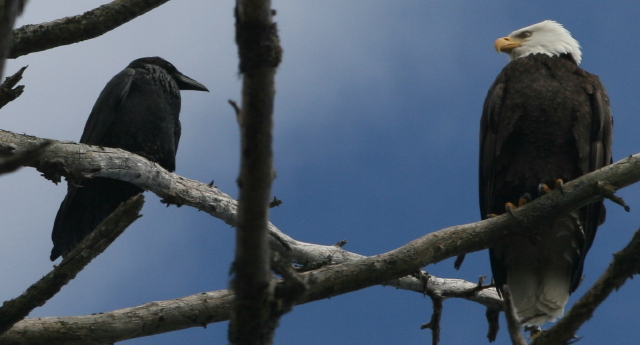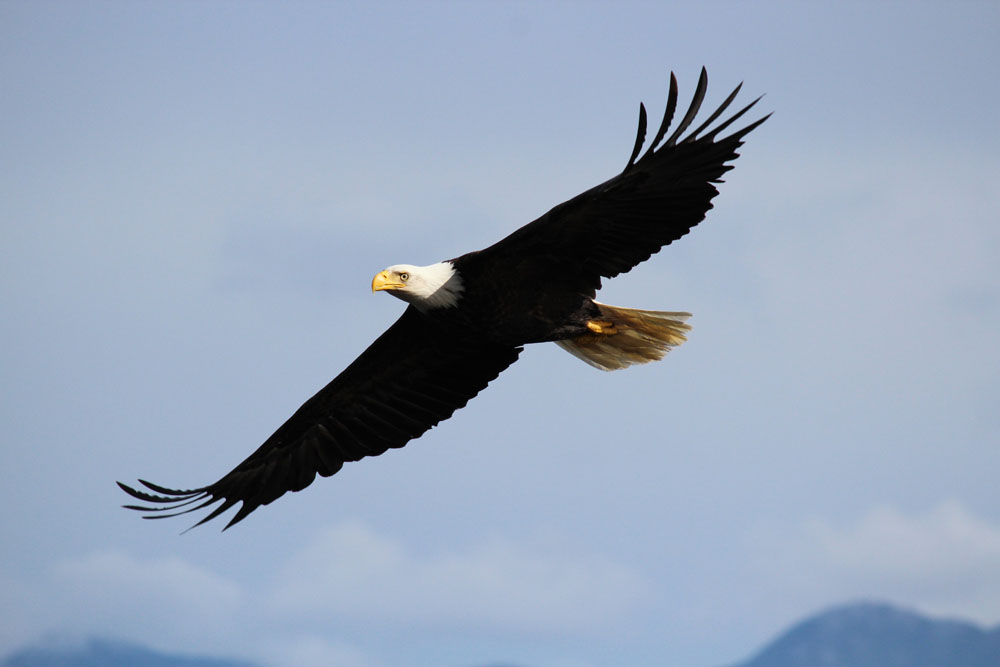Written By; Sole from Spain
This blog post is a story on how someone can go from being a marine scientist and potential orca researcher, to a bald eagle photographer and extreme intertidal explorer in 7 days.
First of all, let me explain what “Ulric Point” is, where it is, and the purpose of this station.
Ulric point is a spot on the Northern end of Aristazabal Island, 16 miles South from Whale Point. Nobody lives there apart from the bears, wolves, minks, bald eagles, and other wildlife. At this remote spot there is a little shelter made of ply wood that overlooks the waters of Caamano Sound. Our little shelter is small and beautiful, but I would not say it is comfortable; sometimes it leaks when it rains. We can hang our cooking utensils from the nails on the wall, the propane stove fits just fine, and the rest of the furniture consist of a VHF radio, 2 batteries, solar panel, a small laptop, the SLR camera and the ‘Big Eyes’ (very powerful, bulky and heavy binoculars).
All of these elements are our working tools. With them we arrived in Ulric on a beautiful, sunny Saturday afternoon, the 2nd of June, ready to document all resident and transient orca activity. For the next days we anticipated spending hours observing their behavior, taking photo ID’s, and listen to their vocalizations. WHAT A GREAT PLAN!!!!
So, as I was saying, we got there the second day of June: Hermann, Aaron, Neekas (the wolf-dog) and myself (Sole). Hermann and Neekas stayed overnight to help us set everything up. We put up our tents, connected the batteries to the solar panel, got the VHF radio ready so we could be in touch with the rest of the world.
On my second day at Ulric I learned how to build a toilet in the rain forest. I will explain the whole process because I find this information very useful and truly believe it could save your life one day:
List of material and working tools: some lumber, a shovel, a saw, an electric –wireless- screwdriver, screws (lots of them) and a toilet seat…oh! And bug spray.
- You dig a deep hole (the depth depends on how much organic material you are planning on deploying there).
- Cut your pieces of lumber to make a structure right on top of the hole you just dug. It has to be about half a meter above the ground level if you don’t want to end up doing sit ups every time you go to the toilet.
- Place one flat piece of ply wood on top of your structure. MAKE SURE IT HAS A HOLE THE SIZE OF A TOILET SEAT!!! Otherwise, the instructions on this manual would end up being useless.
- Put the toilet seat on top of the hole, and screw it onto the ply wood.
VOI LA!!! Your rainforest toilet is served.
Remember: has to be far enough from your tents, but not too far for emergencies, if you know what I mean.
So the station was ready for the season of 2012. Hermann and Neekas were off, back to Gil Island leaving Aaron and I facing wilderness all alone. CHALLENGE ACCEPTED!!!!
June 4th. 7:30am. Binoculars ready, 3 layers of clothes on, and…
“ORCAAAAAAAAAAAAAAAAAAAAS!!!!!!! ORCAAAAAAAAAAAS!!!!”

There they were, 2 nautical miles to the west. One group of 6 whales with two huge males; another group with a mother and calf with two loners further ahead. Imagine our excitement. Our first minutes as killer whale researchers on our own island and we already had lots of swimming mammals around. What other great adventures would be waiting for us around the corner for the next 6 days!?! Probably hundreds of orcas breaching in front of our shelter every day! Sea lions swimming away from the great hunters of the ocean! And much more!!!! All these thoughts filled our minds at that moment, 7:45am on the 4th of June.
Time would soon prove us wrong. Oh so wrong.
For the next days we were working on a 3 hours shift rotations, starting at 6am until 10pm, going to bed with the sunset. While one of us would be at the shelter scanning for whales, the other was free to explore the island.

- To the East: a very long rocky beach, with a beautiful small creek half hour away from our tents. The creek was great for taking a bath, always keeping an eye for curious visitors such as bears or wolves.
- To the West: steep rocks only suitable for very experienced intertidal explorers as ourselves;
- To the South: deep, thick rainforest
- To the North: the ocean. No exploring here. We did not have enough rope to build a raft with all the logs along the shore.
We mastered the slippery-rock climbing; became experts on tide timings for finding intertidal species (sea stars, anemones, mussels, baby rock-fish, limpets, barnacles, etc); took long beach walks holding the bear spray on one hand and the handheld radio on the other; spent a couple of hours setting up a rain water collection device (it didn’t rain for 7 days); did a little excursion into the thick rainforest and found one wolf footprint; made friends with our neighbors the little mink, the bald eagle and his grumpy landlord (maybe “treelord” would be more appropriate) the raven;
put up a tarp to protect our fabulous toilet from the rain (wish it had worked for bugs too); learned to collect sea water directly from our shelter using a bucket and rope so we did not have to climb through the rocks every time; watched four humpback whales feeding 6 or 7 miles* from us (*distance translation: we could only see the blows with the big eyes and under excellent visibility conditions); we tried fishing for salmon from the rocks using a rope and macarroni&cheese leftovers as bait. One evening, two humpbacks visited us for a brief moment 50 meters from the shelter ; and…
…”What about the orcas?” You may be wondering. Well, NOTHING about them, literally. Nada, niente, rien de rien, zero… I do not know where they were, but one thing I am sure of is that they were NOT around Ulric Point.
So we spent half of our 3 hours shifts desperately looking for any sign of these great mammals, and the other half taking photos of our friend the Bald Eagle. I have to confess that we are better rock climbers than photographers, but we keep trying.
And this is how you can go from being a marine scientist and potential orca researcher, to a bald eagle photographer and intertidal extreme explorer in 7 days.

Now I am back in Gil Island. Megan and Aaron are in Ulric looking at the horizon hoping to find those orcas. Wish them luck.
I must say I loved the experience and would go back there at any time, with or without orcas.


